“A very expensive mistake.” Those are the words ESPN used to describe Eden Hazard, the former Chelsea star turned Cristiano Ronaldo replacement.
Despite Real Madrid’s La Liga title during the 2019/20 campaign, Hazard’s first season at the club, injuries and fitness issues have plagued the Belgian. Twice he’s returned from the off-season overweight and out of shape, twice he has sustained early season injuries. Those costly injuries, primarily to his ankle and hamstring, limited him to just 16 La Liga games last season and just six out of Real Madrid’s 18 in the current campaign.
Is it time to say he’s a bust, or, in ESPN’s words, “a very expensive mistake?”
Our tactical analysis will investigate this claim. Tensions are high in Madrid after a Super Copa defeat to Athletic Club, followed by a Copa del Rey loss to 3rd tier Alcoyano. This scout report will offer an analysis of Hazard’s role in the turmoil at Madrid and whether there’s a path back to superstar status for the Belgian.
Limited impact on the dribble
Real Madrid struggles have become a season-long affair. Facing elimination from the UEFA Champions League, the board of directors stood ready to fire Zinedine Zidane. A run of good results, as well as some scintillating displays, saw Los Blancos not only secure the Frenchman’s job, but seemingly buy him immunity through the end of the season. While Hazard played a starring role in the two wins against Inter Milan, he has mostly been missing in action.
In a season and a half at Real Madrid, the Belgian has already missed a total of 43 games due to injury. Adding to the misery is Hazard’s lack of match fitness and ineffectiveness. With a reported transfer fee of €160 million, To say he hasn’t lived up to expectations is the understatement of the year.
So where has he gone wrong?
While he, as well as most of his attacking teammates, simply aren’t passing the eye test right now, I wanted to take a different approach in this scout report. Starting with the data analysis, Hazard’s season contributions were stacked against his wide forward colleagues from La Liga. Known for years as one of the top dribblers in the world, that’s naturally where I started the investigation.
Filtering for La Liga’s wide forwards with 200+ minutes this season, I went about the process by placing Hazard in direct comparison to his competition. the scatter plot below shows dribbles per 90 minutes by dribbling success percentage. As you’ll find in several of the data visualisations, Hazard is highlighted with a golden circle.
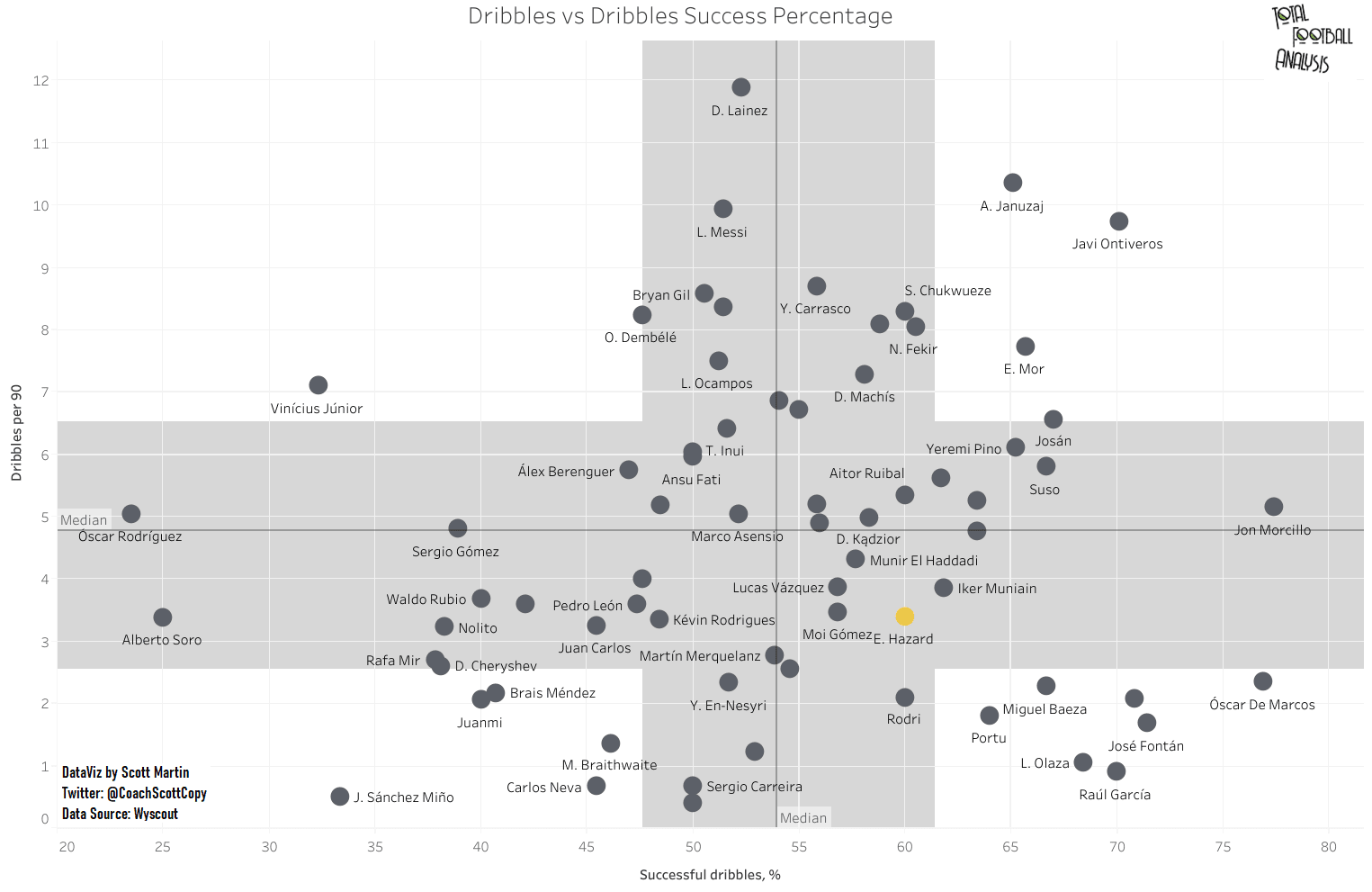
As you would expect, Hazard rates in the top half of the league in his dribble success percentage, hitting the 60% mark. However, his 3.4 dribbles P90 rate in the 37th percentile.
That’s a far cry from his 2019/20 performance. Much like his Chelsea days, Hazard demanded that his teammates play into his feet, activating his dribble. As you can see in the chart below, he averaged roughly 8.2 dribbles P90 last season.
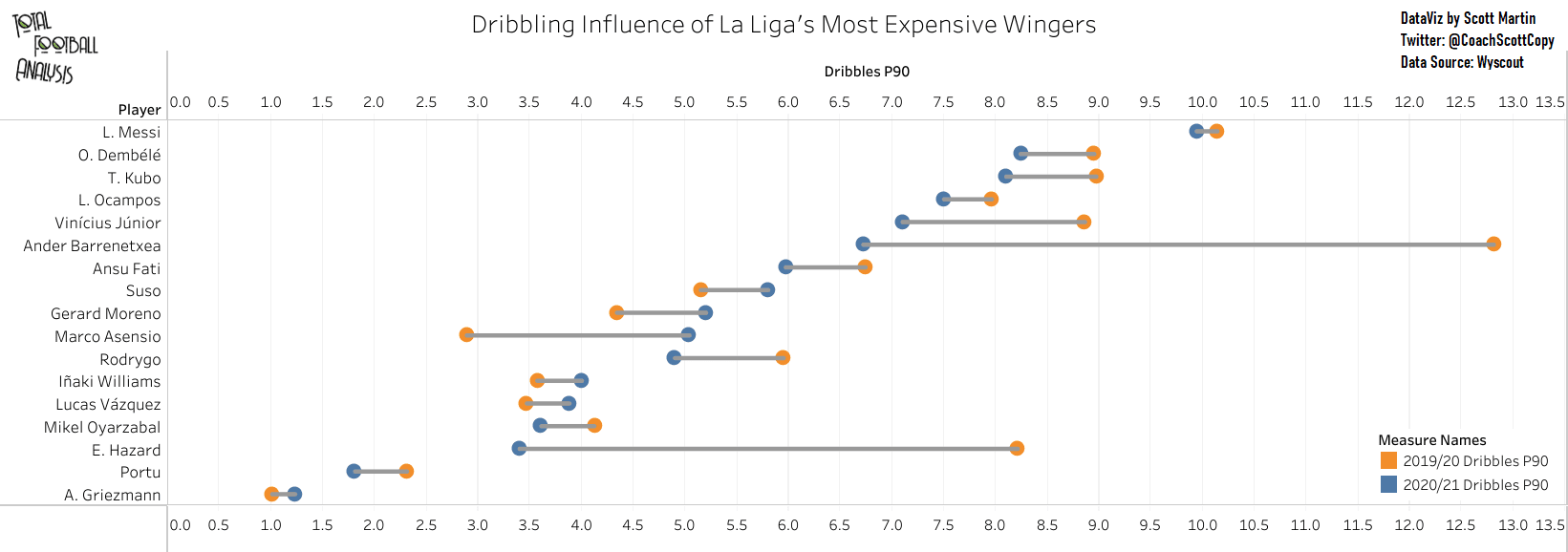
The dumbbell chart above places him in direct comparison to La Liga’s most valuable wide forwards who have earned minutes over the past year and a half, each having a market value of €15m or more. Last season, Hazard was among the leaders in the dribbles per 90 minutes category. However, we see the steep drop off this season, only rating above Real Sociedad’s Portu and Barcelona’s Antoine Griezmann.
With a player of Hazard’s quality, there’s an expectation that he use his individual ability to create qualitative superiorities. Prior to this season, you’d often find him isolated against a defender, ready to wreak havoc from the left-wing. That simply hasn’t been the case in 2020/21.
A couple of reasons come to mind.
First, injuries have surely taken a toll. Between a fractured ankle, multiple hamstring strains and various other muscle injuries, there doesn’t seem to be a level of comfort in the acceleration following a dribbling feint. He’s still moving reasonably well, but the extra force necessary to beat a defender doesn’t seem to be there at the moment. There is the possibility that he’s still trying to regain strength, but it’s important to keep in mind that he now has a very detailed injury history and is on the wrong side of 30.
The second reason for his plummeting dribbling rates is the tactical interaction with Ferland Mendy. Though Hazard prefers to play high and wide, or at least start there before making his half space drops between the lines, Mendy’s lack of press resistance means he’s better suited in the open spaces of the wings.
Mendy’s width starts a chain reaction, pushing Hazard into the half space. In the recent Super Copa game against Athletic Club, Mendy and Toni Kroos worked together in the wing, pushing Hazard into the left half space. Initially, it appears as though Hazard has found a pocket of space to receive on the half turn and attack the space in front of him.
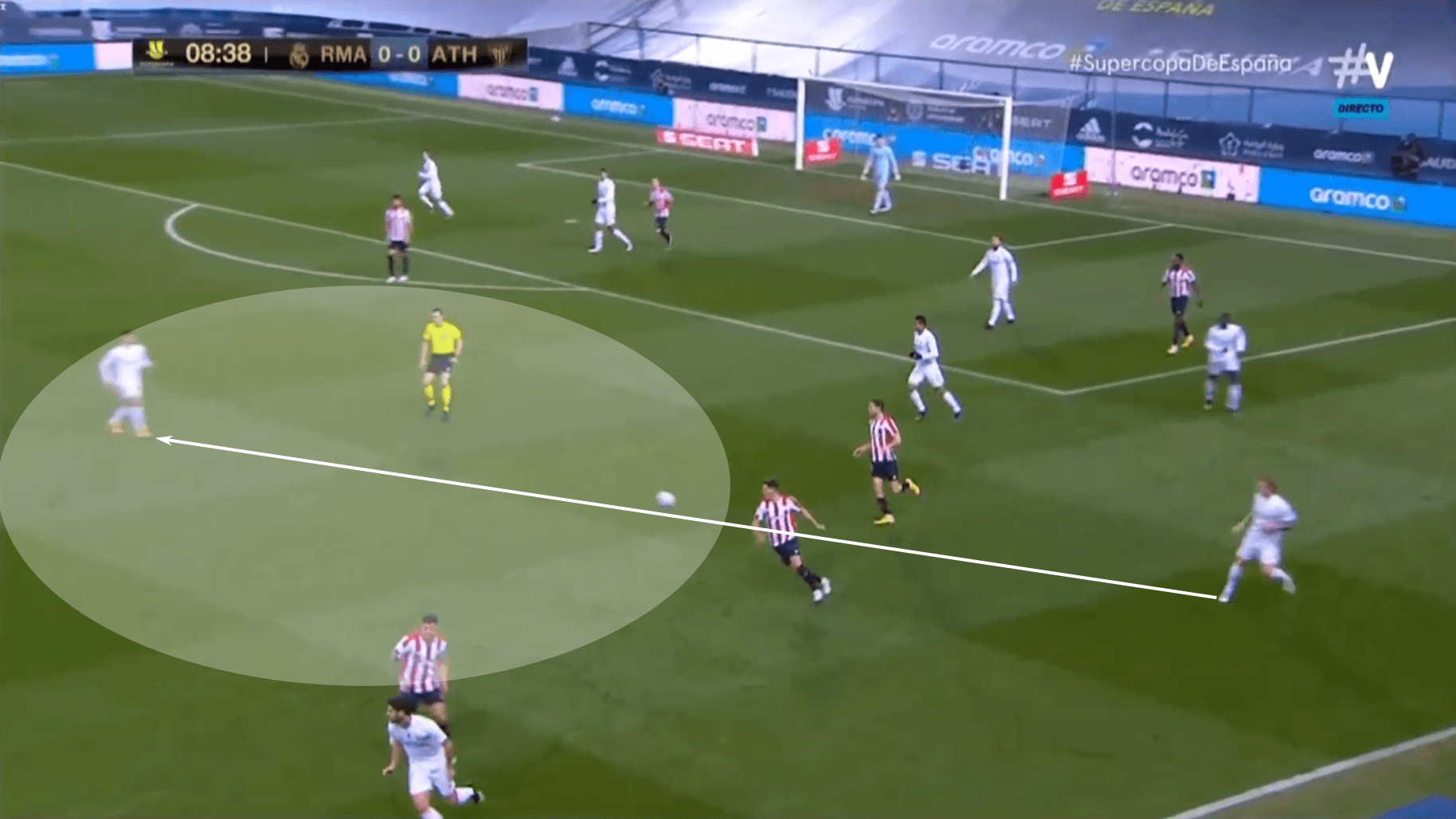
However, he’s quickly closed down. A sliding tackle sends the ball two Raúl García’s feet, nearly ending in an Athletic Club goal.
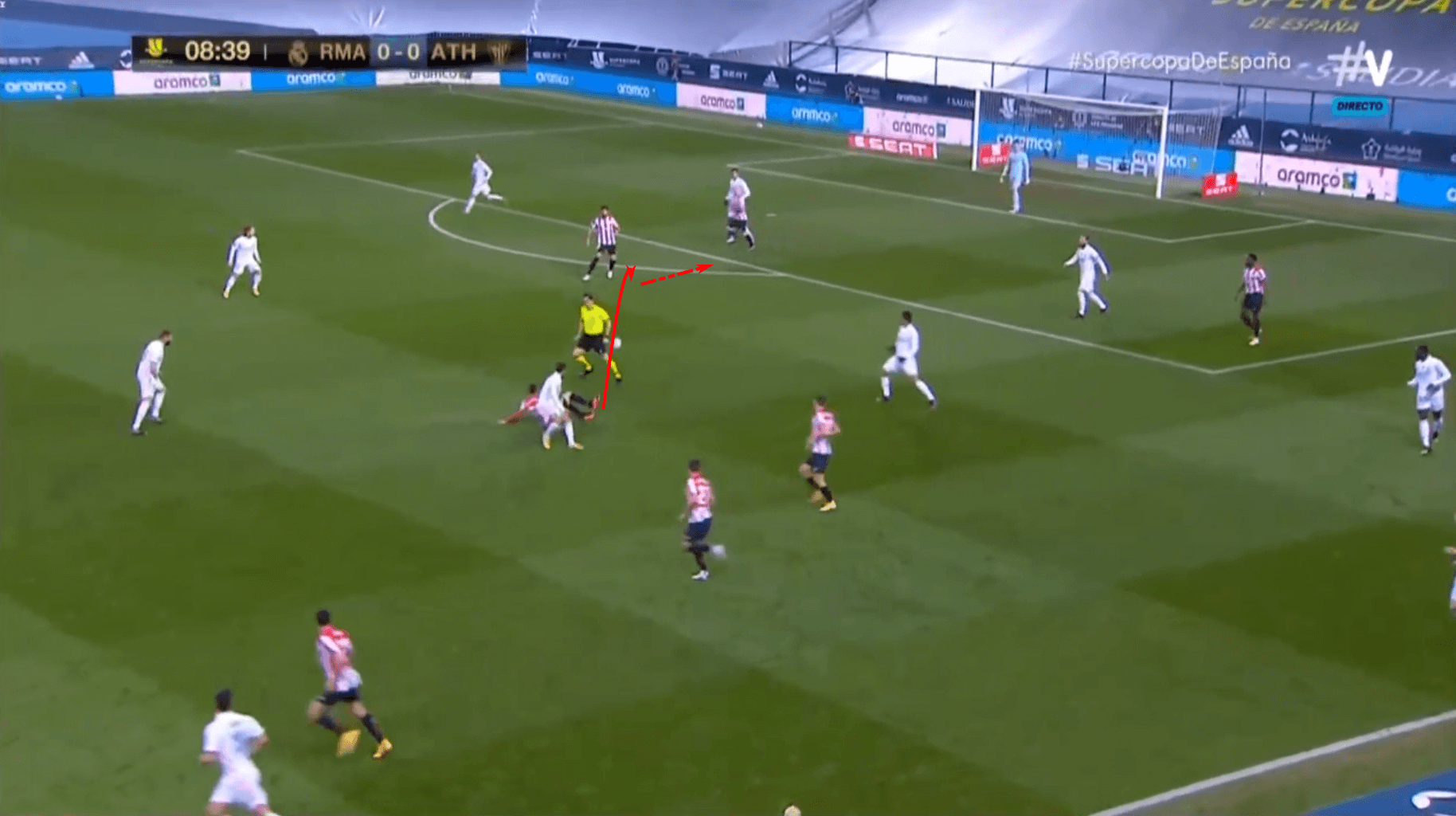
In the bottom of the image, you see Marco Asensio situated as the highest and widest player on Real Madrid’s left-hand side. When he and Hazard are in the lineup together, there is the issue that both players prefer the left side of the pitch. Adding to the difficulty is that they are very similar players, each wanting the ball played into his feet, making it more difficult to stretch the opposition’s backline.
As the saying goes, good players can always find a way to play together. But has that worked for Real Madrid?
Very little goal contribution
Ever since Cristiano Ronaldo left the White House for Juventus’ striped kit, Real Madrid has made an adventure of goalscoring. Though they’ve generally rated just below Barcelona in the category, goals per game have been an issue for Los Merengues.
After a disastrous 2018/19 season, the club brought in Hazard to put those concerns to rest.
With just one goal and four assists in his first season at Madrid, those numbers coming from a 3.31 xG and 3.85 xA, he certainly didn’t squelch those concerns. His goal contributions continue to be a source of concern in 2020/21.
The scatter plot below visualises xG by xA, both on a per 90 minutes basis. Shockingly, Hazard has yet to earn his first xA contribution this season. Keep in mind, the stats are strictly for La Liga matches. In the 265 league minutes he has played, Hazard has only managed 0.62 xG, which puts him at 0.21 xG P90, hardly an inspiring figure.
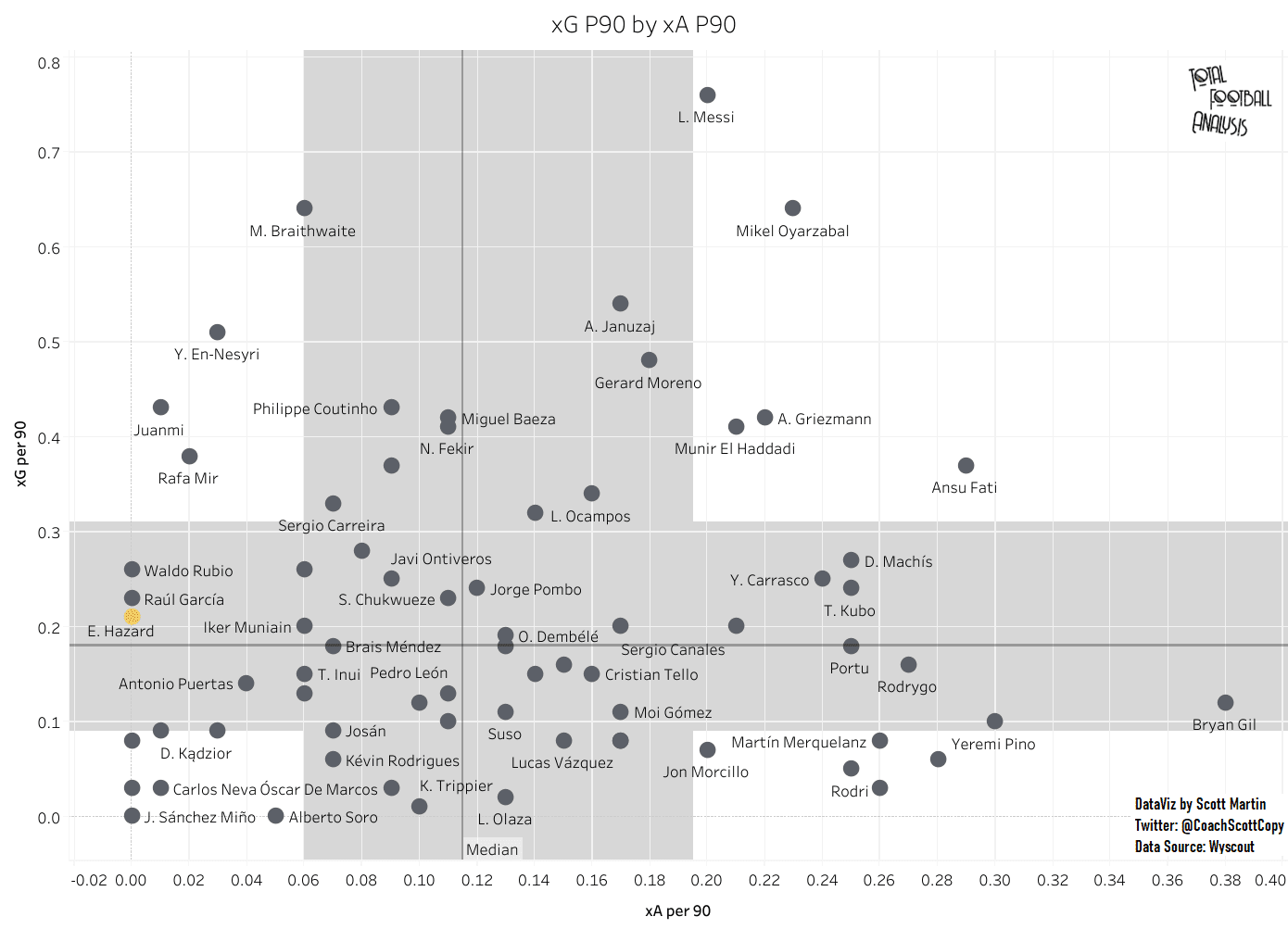
It’s not just that he’s struggling to score goals. He’s also failing to provide adequate service to his teammates, which is especially problematic when you consider last seasons top two goal-scorers, Karim Benzema and Sergio Ramos, are service dependent players. Hazard is getting his touches in the box, but he simply isn’t making the most of them.
Here we see that he rates reasonably well in touches in the box per 90 minutes, but his passes to the penalty area P90 rate near the 15th percentile among La Liga wide forwards.
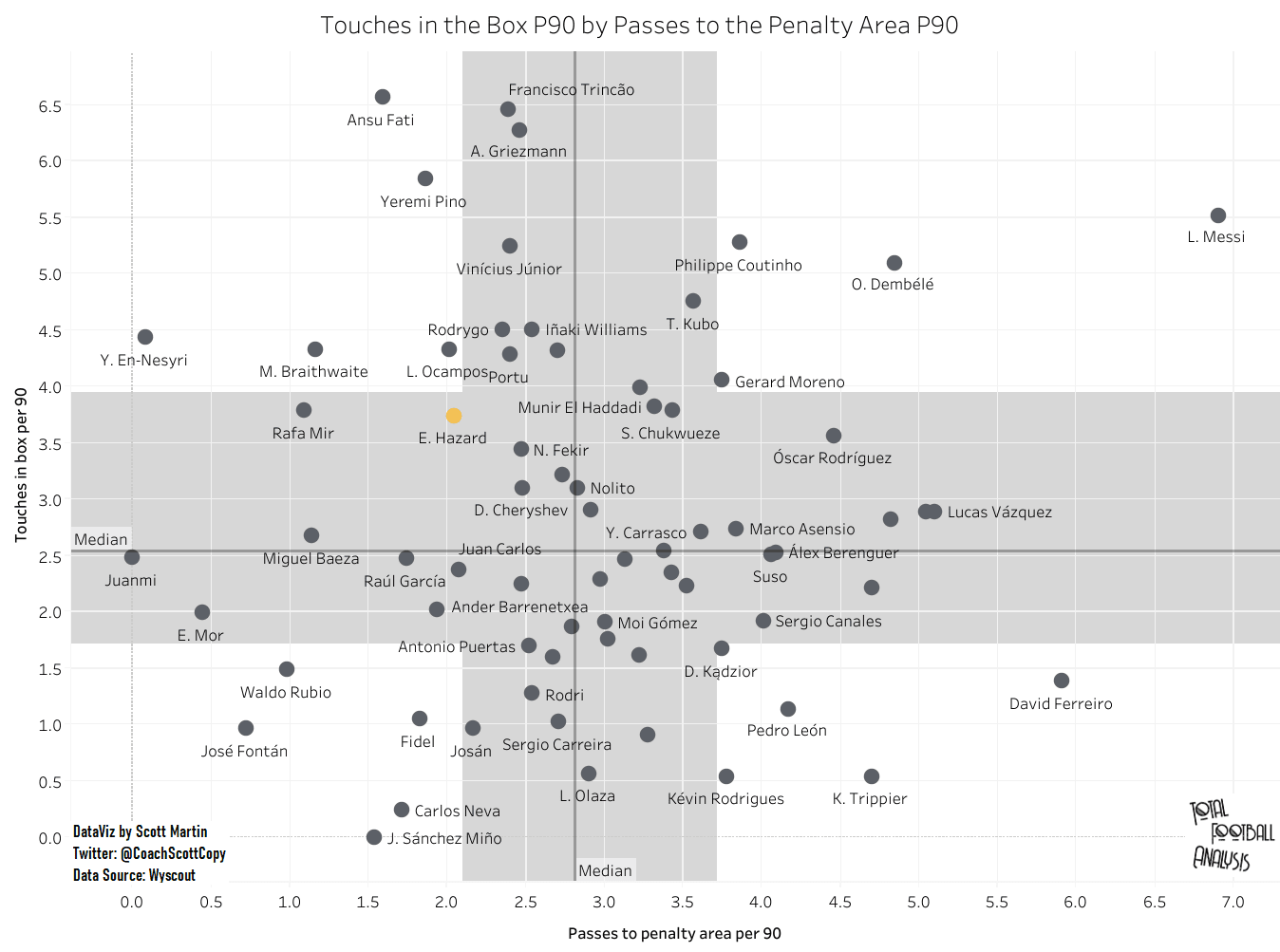
On film, one of the issues is that he does tend to drift centrally to draw the opponents attention, creating space for teammates. Much like Lionel Messi, he’s operating more as a playmaker than a goal-scorer.
Complicating matters, when he does look to receive on the left side of the pitch, Real Madrid’s wide overloads are drawing too much attention to him. Hazard excels in 1v1 situations. Even when space behind the first defender is reasonably well covered, he still has the ability to beat the first defender to set up the pass around the 2nd.
However, much like the example below from the Celta de Vigo game, he’s rarely able to receive the ball while in isolation. Here we see Benzema and Kroos joining him after a long switch of play.
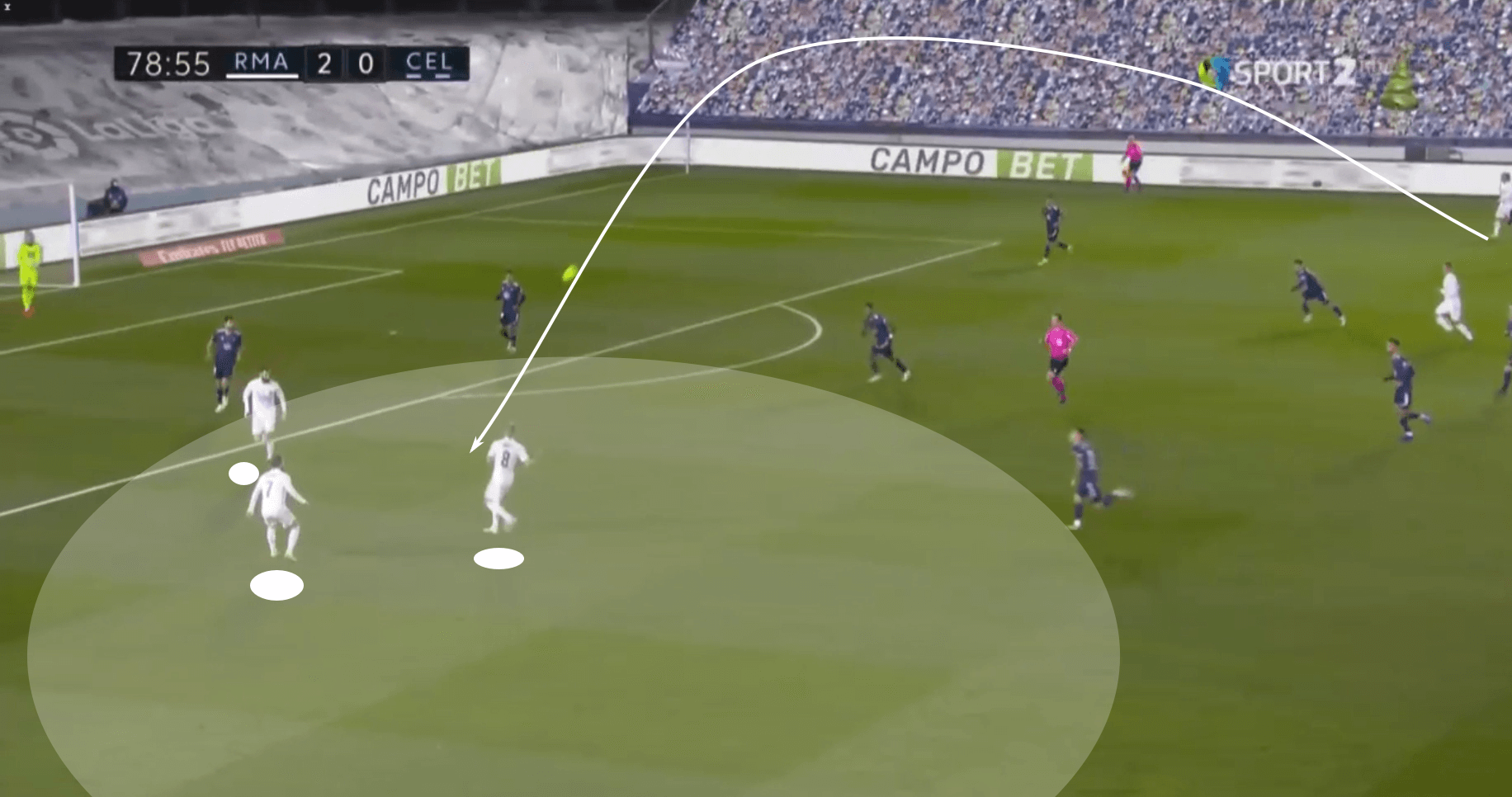
Had Benzema looked to stay high and stretch the defence and Kroos simply left the ball for Hazard, the Belgian would have had a scenario that best suits him. He’s a player who needs to run at defenders and unleash his extraordinary 1v1 ability. Much like the NBA’s LeBron James, he’s a player who needs isolation to work his magic.
Expectation vs reality
So where does Real Madrid stand? Better yet, where does Hazard stand?
Despite missing over half of the 2019/20 league schedule, Hazard managed to produce respectable numbers last season. Nowhere near his expected output, but decent numbers nonetheless. When he did manage to play, Real Madrid was a better team because of the talents he brings to the pitch.
From a per 90 minutes statistical standpoint, his 2019/20 season showcased his excellent passing and playmaking abilities. If there was any one area where he was statistically underwhelming, it was in the categories relating to goals.
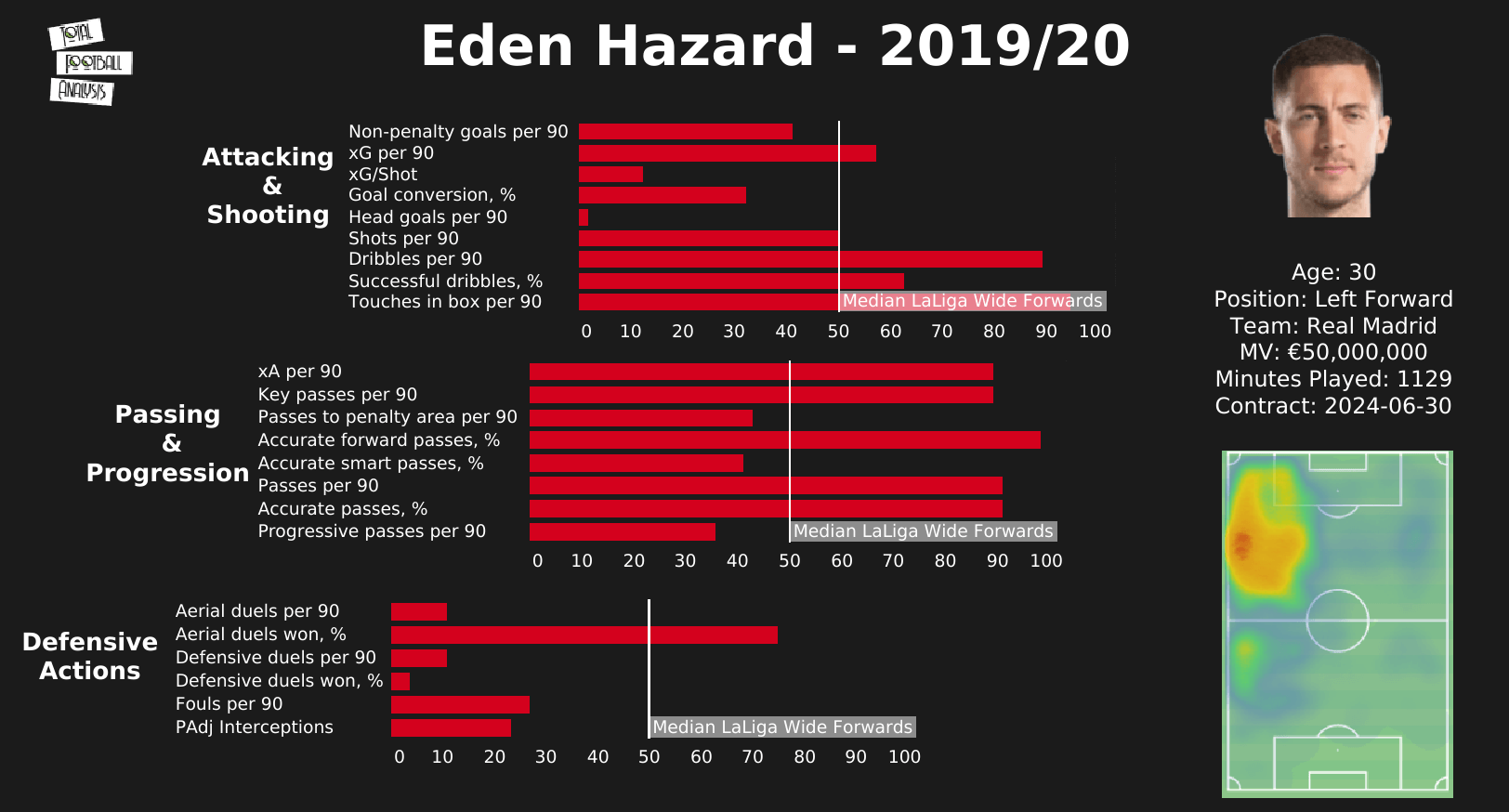
Real Madrid knew the side would suffer defensively with Hazard on the pitch, but any defensive work is just the cherry on top. A poor defender, he will at least put in some sprints during the high press and counterpress.
Another thing to note from his profile is his heat map. That bright red spot is nearly hugging the touchline. His heat map shows a high and wide winger who likes to move into the left half space when the opportunity arises. Keep that in mind. We’ll return to it in a moment.
But first, we need to identify the problem Hazard’s transfer was supposed to solve, Ronaldo’s missing goals. During Ronaldo’s final season at the club, he and his teammates managed 2.42 goals P90 on 2.18 xG. Some degree of drop off from those spectacular numbers was expected, but the 2018/19 campaign, the season Gareth Bale was expected to lead the team, the club saw massive declines in both categories. With Hazard in the team the following year, xG declined once again, but goals per 90 minutes saw a 0.11 improvement.
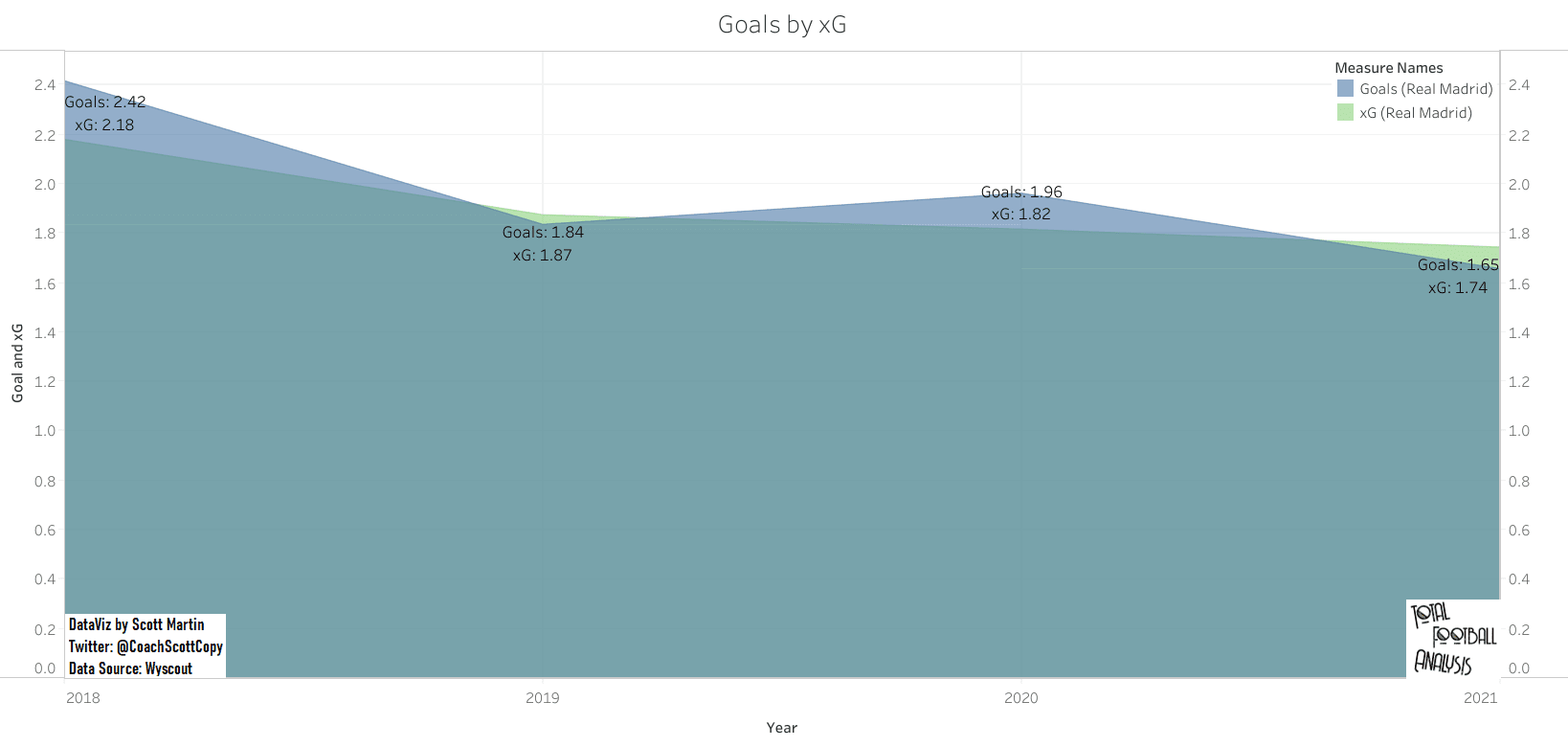
In 2020/21, each of those numbers is in a steady decline. Real Madrid are averaging 1.65 goals on 1.74 xG P90.
To make matters worse, the team’s defensive work has been rather shoddy most of the season. Ramos’s injuries certainly haven’t helped matters. Without the captain anchoring the backline, this side does occasionally look lost. Even still, statistical regression from last season is rather shocking on both sides of the ball.
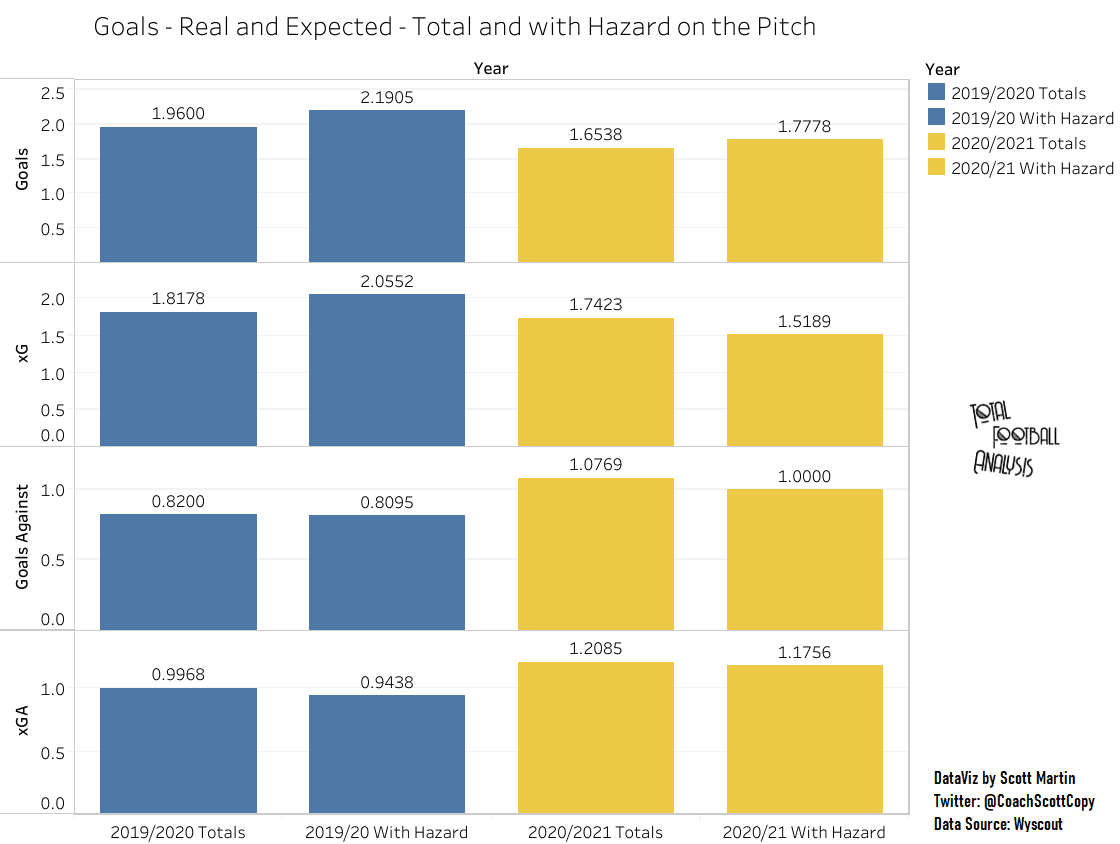
These stats show Real Madrid’s total numbers for the previous season and a half, as well as their numbers when Hazard plays. Last season, his presence contributed to better statistical outcomes in the average match.
Surprisingly, the side’s defensive performances are better in 2020/21 with Hazard than without him. That’s in large part due to their possessional dominance and the quality of the teams they have faced when Hazard has played.
So, how does his 2020/21 statistical profile compare to the previous season?
His goal-related stats have seen an uptick, but his passes leading to shots or box entries rate among the worst at the position.
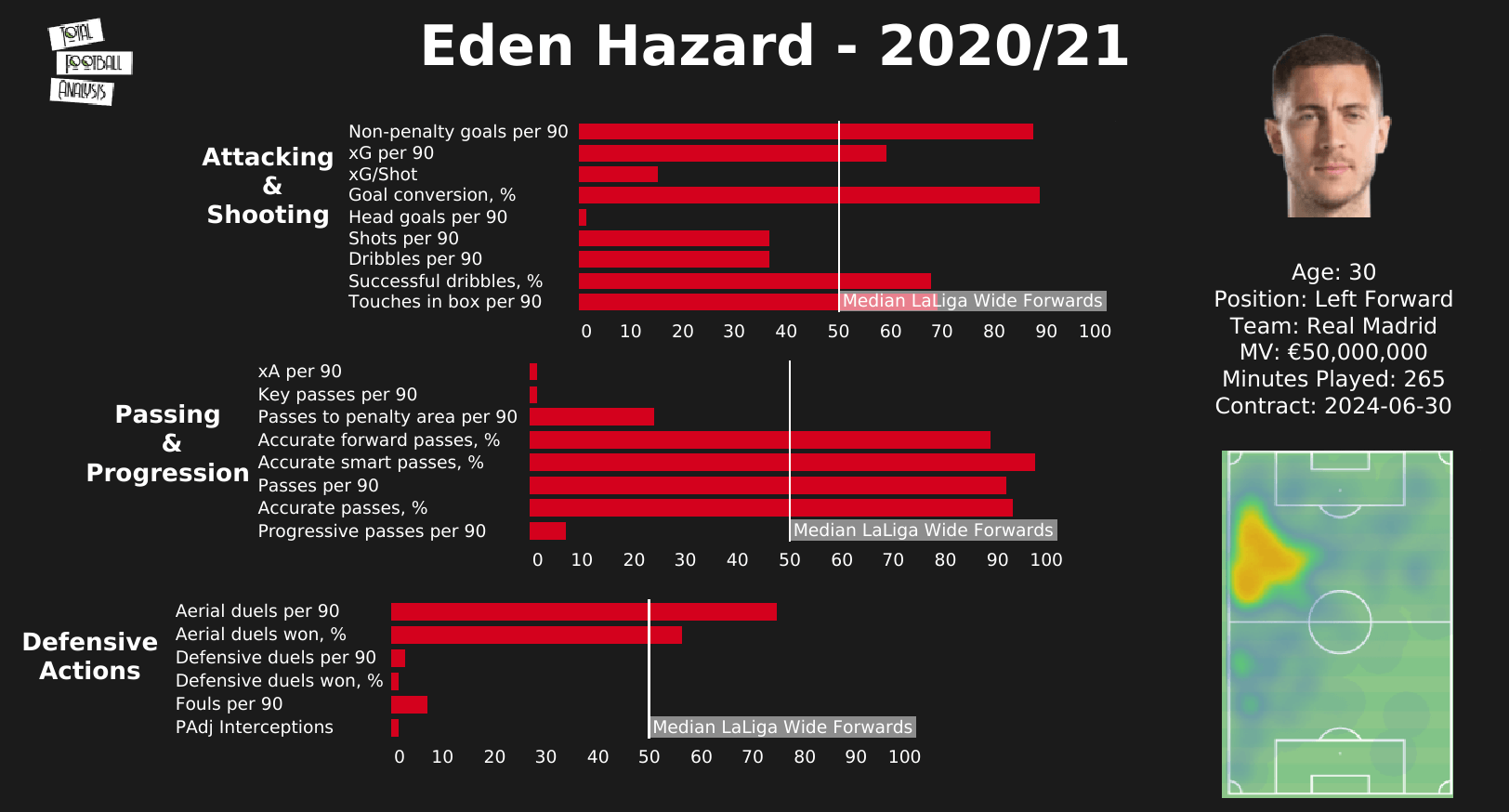
Coming back to his heat map, if you compare this campaign to last season, he’s not hugging the line quite as much, nor is he receiving the ball quite as high. Additionally, there’s more coverage in the half space. The scattered, light blue tints to the heat map show that he is moving across the pitch more frequently, moving toward space to receive rather than letting the ball work its way to him. Rather than isolation to set up a 1v1 in the wing, he’s roaming the field in search of the ball, limiting his contributions higher up the pitch.
Conclusion
So, is Hazard “a very expensive mistake?”
It’s too soon to give a definitive answer in one direction or the other, but the return on investment is certainly underwhelming. This analysis has not only covered Hazard’s contributions and some of the tactical issues he’s encountering, but also addressed the price of the transfer and the void left by Ronaldo. Like it or not, Hazard was brought in as a direct replacement for Ronaldo. In that regard, his output does not justify the cost, especially since the Portuguese his average nearly a goal a game since joining Juventus.
That said, Hazard can return from this brutal slump. Returning to health is the first step. He simply can’t lose much more time. If he can remain healthy enough to build up some match fitness, he will finally have the opportunity to work with his teammates for an extended period of time, developing his cohesion with the players around him. Finally, Zidane must arrange his tactics to get the best out of the Hazard/Benzema partnership.
The season is still relatively young and the club is by no means out of the title race, but, given Atlético Madrid’s form and their refusal to drop points, Real Madrid simply can’t afford to drop any themselves. To claw their way back to the title, Hazard will have to show that he was worth every cent.





Comments